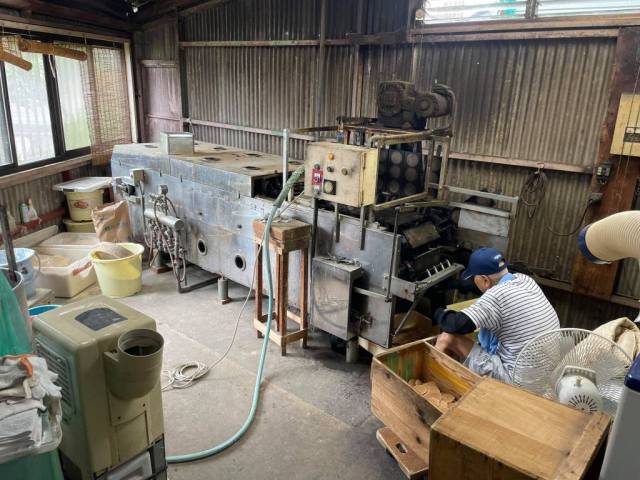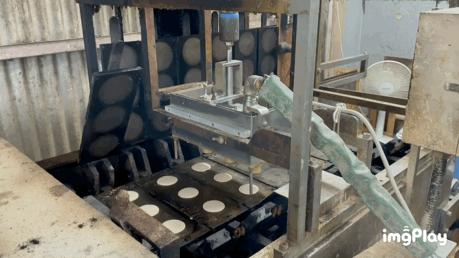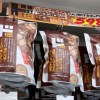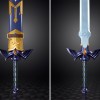
The oldest shika senbei maker in the city gives us an inside look and a fresh-cooked taste.
Nara has several temples, shrines, and statues of historical significance, but arguably the biggest draw to the city is its herds of deer which freely roam its central park and streets. Though they’re wild animals, the deer are an integrated part of the community, calmly and cheerfully interacting with human locals and visitors.
The deer are such a symbol of the city that they even have their own special snack, called shika senbei (“deer crackers”). It’s said that these deer treats were first made in the early Edo period (which began in 1603). Today, there are five companies that produce them, and our Nara-based reporter, K. Masami, paid a visit to the oldest one to see how they’re made.
▼ Deer crackers
Takeda Toshio Shoten’s history doesn’t quite stretch back to the feudal era, but it can trace its roots to the early Taisho era. As a matter of fact, when Nara’s Kasuga Grand Shrine made its first official proclamation designating authorized deer cracker makers back in 1917, Takeda Toshio Shoten was listed on the parchment, so they’ve got more than a century of industry experience.
Masami was met at the door by the current owner, Takeda-san, and as soon as she stepped through the doorway she could smell the aroma of roasting crackers. Following the scent to the back of the building, they arrived in the production area.
Unlike the delicious but highly processed snacks we humans stuff ourselves with, deer crackers are made from only three basic ingredients: rice bran, wheat, and water. Right at the start, these get stirred together by a mixing machine.
Once they’re blended smoothly together, the batter is transferred to the grilling machine, where it drips into circular molds.
After the molds are filled, the line advances and a hot iron plate comes swinging down, flattening the batter out and flat-grilling the crackers.
“Would you like to try a fresh-cooked one?” Takeda asked, and Masami was initially hesitant. Deer crackers are deer snacks, not people ones, right? But then she thought about the ingredients. Rice and wheat are both edible, right? If anything, they’re healthy, and there’s no added salt, sugar, or oil to deer crackers either.
So she took a bite, and…
…it was surprisingly tasty! With no extra flavorings, she’d expected it to be bland, but the fresh-cooked deer cracker had a delicious graininess to it, plus a satisfying crunch and comforting warmth.
“And here’s a room-temperature one, for comparison,” Takeda said, handing her a second helping, and this time the sensation was far more “animal feed” than “people food.” Cooled down, the harsher notes of the flavor profile start to stand out, so if you’re going to eat a deer cracker for some reason, Masami highly recommends making it one that’s fresh off the line.
Once the crackers are cooked, the next step is packaging. They’re sold in stacks of 10, held together by a strip of paper furnished by the Nara Deer Preservation Foundation in exchange for a fee that’s used to fund deer welfare programs.
Masami noticed that each strip was sealed using a glue-like adhesive, and Takeda explained that this is a special substance that not only holds the paper together, but is also safely digestible by deer, in case they happen to bite off a piece of the wrapper.
As Masami said her goodbyes to Takeda and his staff, she couldn’t help smiling at how much care and craftsmanship goes into the deer crackers, despite the incredibly low price they sell for, and if you’d like to visit Takeda Toshio Shoten for yourself, tour reservations can be made by phone at the number listed below.
Location information
Takeda Toshio Shoten / 武田俊男商店
Address: Nara-ken, Nara-shi, Narazaka-cho 2476-2
Telephone: 0742-22-4853
Photos ©SoraNews24
● Want to hear about SoraNews24’s latest articles as soon as they’re published? Follow us on Facebook and Twitter!
[ Read in Japanese ]















 With foreign visitor numbers to Nara Park plummeting, are the city’s deer in danger of starving?
With foreign visitor numbers to Nara Park plummeting, are the city’s deer in danger of starving? Nara deer shikadamari mystery deepens as tourists return to Nara park
Nara deer shikadamari mystery deepens as tourists return to Nara park Nara unveils new vending machines that sell deer crackers
Nara unveils new vending machines that sell deer crackers The poo from Nara Park’s deer is changing because of the coronavirus pandemic
The poo from Nara Park’s deer is changing because of the coronavirus pandemic Nara asks visitors to stop feeding the deer
Nara asks visitors to stop feeding the deer Swinging an umbrella while walking has same force as a piano, Tokyo government claims
Swinging an umbrella while walking has same force as a piano, Tokyo government claims What are you supposed to do with your backpack on a crowded train in Japan?
What are you supposed to do with your backpack on a crowded train in Japan? Japan’s new Mister Donut matcha donuts have so much green tea flavor one has to use the hole
Japan’s new Mister Donut matcha donuts have so much green tea flavor one has to use the hole Studio Ghibli announces new anime short in production, now recruiting staff to make it
Studio Ghibli announces new anime short in production, now recruiting staff to make it Tokyo sakura report: Why Shinjuku Gyoen beats Ueno Park for hanami cherry blossom viewing
Tokyo sakura report: Why Shinjuku Gyoen beats Ueno Park for hanami cherry blossom viewing Changes to Japan rail pass make it fall out of favour with travellers
Changes to Japan rail pass make it fall out of favour with travellers Our reporter tries amemonaka, the traditional sweet from Niigata Prefecture
Our reporter tries amemonaka, the traditional sweet from Niigata Prefecture Instant cozy anime cosplay can be yours with new Ranma 1/2 roomwear sets【Photos】
Instant cozy anime cosplay can be yours with new Ranma 1/2 roomwear sets【Photos】 New Monster Hunter plushies let you be a Monster Hugger instead【Photos】
New Monster Hunter plushies let you be a Monster Hugger instead【Photos】 Japanese shiitake mushroom snacks from Don Quijote, created for people who don’t like mushrooms
Japanese shiitake mushroom snacks from Don Quijote, created for people who don’t like mushrooms First One Piece Day outside of Japan draws huge crowds
First One Piece Day outside of Japan draws huge crowds McDonald’s Japan renews the Samurai Mac, but not everyone will be happy with the new warrior
McDonald’s Japan renews the Samurai Mac, but not everyone will be happy with the new warrior Uniqlo combines art of Doraemon and Leonardo da Vinci in new Louvre crossover T-shirt line【Pics】
Uniqlo combines art of Doraemon and Leonardo da Vinci in new Louvre crossover T-shirt line【Pics】 Tokyo trains now have new first-class Green Cars, but are they a sell-out hit?
Tokyo trains now have new first-class Green Cars, but are they a sell-out hit? Starbucks Japan’s Snoopy Frappuccino is here!【Taste test】
Starbucks Japan’s Snoopy Frappuccino is here!【Taste test】 Department store rooftop in Tokyo is a secret oasis above the city
Department store rooftop in Tokyo is a secret oasis above the city Real-life Ghost of Tsushima shrine announces ban of all “tourists,” but there’s some fine print
Real-life Ghost of Tsushima shrine announces ban of all “tourists,” but there’s some fine print Japanese man who ate at same beef bowl chain for 2,000 days in a row announces he’s gotten married
Japanese man who ate at same beef bowl chain for 2,000 days in a row announces he’s gotten married Latest Japan cherry blossom forecast pushes Tokyo date back, sakura now expected first elsewhere
Latest Japan cherry blossom forecast pushes Tokyo date back, sakura now expected first elsewhere Updated cherry blossom forecast shows extra-long sakura season for Japan this year
Updated cherry blossom forecast shows extra-long sakura season for Japan this year Traditional Japanese mochi dessert inspires McDonald’s newest pie flavor
Traditional Japanese mochi dessert inspires McDonald’s newest pie flavor Secret staff cafeteria in Tokyo Metropolitan Government Building serves up an exclusive ramen
Secret staff cafeteria in Tokyo Metropolitan Government Building serves up an exclusive ramen Studio Ghibli unveils new Mother’s Day gift collection, with flower sets and a special acorn tea
Studio Ghibli unveils new Mother’s Day gift collection, with flower sets and a special acorn tea Secret onsen hot spring is a hidden gem in Tokyo
Secret onsen hot spring is a hidden gem in Tokyo My Neighbour Totoro rice cookers and pots bring Studio Ghibli anime flair to your kitchen
My Neighbour Totoro rice cookers and pots bring Studio Ghibli anime flair to your kitchen McDonald’s new Happy Meals offer up cute and practical Sanrio lifestyle goods
McDonald’s new Happy Meals offer up cute and practical Sanrio lifestyle goods Foreign tourists on Shinkansen bullet train break suitcase etiquette, angering local passengers
Foreign tourists on Shinkansen bullet train break suitcase etiquette, angering local passengers Possessing Harry Potter’s Sword of Godric Gryffindor is now illegal in Japan
Possessing Harry Potter’s Sword of Godric Gryffindor is now illegal in Japan [Deleted] Article written for April Fool’s Day 2018
[Deleted] Article written for April Fool’s Day 2018 Japan’s deadliest food claims more victims, but why do people keep eating it for New Year’s?
Japan’s deadliest food claims more victims, but why do people keep eating it for New Year’s? Foreigner’s request for help in Tokyo makes us sad for the state of society
Foreigner’s request for help in Tokyo makes us sad for the state of society Japanese convenience store Family Mart announces abolishment of eat-in spaces
Japanese convenience store Family Mart announces abolishment of eat-in spaces Life-size vibrating Legend of Zelda Master Sword for sale from Nintendo【Photos】
Life-size vibrating Legend of Zelda Master Sword for sale from Nintendo【Photos】 Studio Ghibli releases free-download board game — Here’s how to play it without reading Japanese
Studio Ghibli releases free-download board game — Here’s how to play it without reading Japanese Princesses, fruits, and blacksmiths: Study reveals the 30 most unusual family names in Japan
Princesses, fruits, and blacksmiths: Study reveals the 30 most unusual family names in Japan Increased tourist numbers in Nara Park are affecting the size of its deer population
Increased tourist numbers in Nara Park are affecting the size of its deer population Nara deer shikadamari phenomenon continues to baffle visitors at Nara park
Nara deer shikadamari phenomenon continues to baffle visitors at Nara park Nara deer “addicted” to rice crackers, lose weight with no tourists to feed them
Nara deer “addicted” to rice crackers, lose weight with no tourists to feed them Deer in Nara Park outnumber visitors, display baffling summer gathering behaviour
Deer in Nara Park outnumber visitors, display baffling summer gathering behaviour Deer in Nara Park mysteriously disappear during this year’s shikadamari season
Deer in Nara Park mysteriously disappear during this year’s shikadamari season Shikayose: The Calling of the Deer in Nara with acorns and a French horn
Shikayose: The Calling of the Deer in Nara with acorns and a French horn Bizarre “shikadamari” deer gathering at Nara Park baffles people in Japan
Bizarre “shikadamari” deer gathering at Nara Park baffles people in Japan Nara’s “deer cookie” rice crackers get their first price increase in 28 years
Nara’s “deer cookie” rice crackers get their first price increase in 28 years A senbero with deer in Nara Park turns into a weird fever dream
A senbero with deer in Nara Park turns into a weird fever dream Shikadamari: The Nara deer summer gathering phenomenon that baffles visitors every year
Shikadamari: The Nara deer summer gathering phenomenon that baffles visitors every year Nara Park’s first baby deer of the year has been born, is totally adorable【Video】
Nara Park’s first baby deer of the year has been born, is totally adorable【Video】 Nara deer heading farther outside park during the coronavirus outbreak, but will they come back?
Nara deer heading farther outside park during the coronavirus outbreak, but will they come back? Why isn’t there more deer poo in Nara Park? This very strange museum has the answer【Photos】
Why isn’t there more deer poo in Nara Park? This very strange museum has the answer【Photos】 Starbucks releases 47 Frappuccinos around Japan, we try the one for Nara Prefecture
Starbucks releases 47 Frappuccinos around Japan, we try the one for Nara Prefecture Eat a mountain of chicken katsu at this restaurant in Nara【Photos】
Eat a mountain of chicken katsu at this restaurant in Nara【Photos】 Japanese meat buns with deer meat?!? Taste-testing Nagano’s shikanikuman【Taste test】
Japanese meat buns with deer meat?!? Taste-testing Nagano’s shikanikuman【Taste test】
Leave a Reply